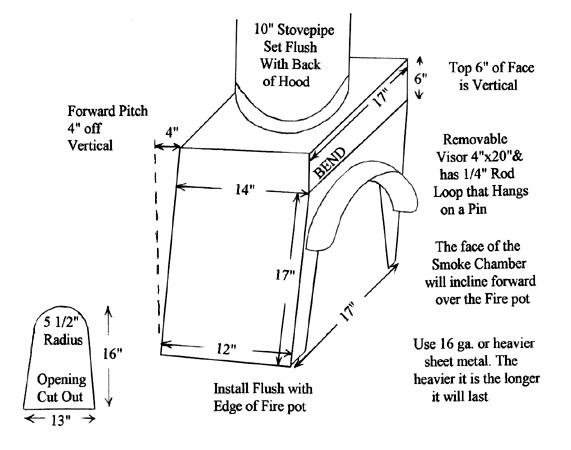A Simple Shop-Built Side Draft Forge
By: Dan Cruzan
The advantage of a side draft forge is that the fire is completely
out in the open. That way it is easy to see what is happening and easy
to position the work in the fire.

My forge is merely a "table" made from 1/4 inch plate for a top
and has angle iron legs, with an angle iron rim. The table top is
sufficiently reinforced underneath with flat iron welded on edge to
keep the table flat. A hole is cut to accept the fire pot so that the
fire pot is as close as possible to the smoke chamber. The fire pot
just sits in the hole being held up by its flanges. I used a fire pot
from Laurel Machine and Foundry Company, Laurel, Mississippi. 601-428-0541.
It's a good heavy fire pot with clinker breaker for about $80.00. A
good value in my opinion. At the front of the forge I included a tool
rack made from 1/4 x 2 flat from which tongs, poker, or whatever can be
hung. Not pictured, but also included is a "third hand" to help with
long pieces. This was made by welding two ears on the bottom of the forge rim
on the work side. A piece of 5/8 rod is bent into a square cornered U
with 2 inch right angle bends at the top of the U. The ends of the 5/8 rod
are put into a hole in each ear. A leg is made from 5/8 square stock with
an eye in one end that goes around the 5/8 rod at the bottom of the U.
When the U is pulled up into place, the leg hits the floor and supports
it. At the back of the forge two angle irons are bolted to receive the
smoke chamber.

The smoke chamber is basically the same as one in a handout from Frank
Turley's Blacksmithing School. I don't know if it's his design or someone
else's, but it works very well. I have a removable visor which is rarely
needed on the smoke chamber. The smoke chamber sits between and is bolted
to the two angle irons bolted at the back of the forge. I have a 10 inch
smoke pipe that is about 16 feet long, fitted with a chinaman's cap. It
ends at about 2 feet above the peak of the shop roof. The smoke chamber
draws very well and I have no problems with smoke in my shop unless
a 10 x 12 foot door that is about 6 foot from my forge is open and a
cross breeze blows across my fire.
A note about chimneys:
- Sufficient Fresh Air: For a chimney to draw properly, it is
essential that enough fresh air is entering the building to
replace the air consumed by the fire that goes up the chimney.
I believe many smoke problems are caused by this lack of fresh
air entering the building.
- Chimney Height: Generally speaking, the higher the chimney,
the better the draw. A higher chimney contains a larger volume of
gases which are less dense than the surrounding air. This
creates a larger pressure differential causing better draw.
- Outside Air Turbulence: The outlet of the chimney must be
sufficiently away from the peak of the building, trees,
or any other obstacles which may create air turbulence at
the top of the chimney.
- Chimney Size: A chimney needs to be of the proper size to
handle the quantity of smoke given off by the fire. If it is
too small smoke canít get through, too large and the flow
becomes turbulent as well as the column of smoke becoming
more dense. Too large a chimney is usually not a problem.
- Size of Opening in Smoke Chamber: The smoke chamber opening
needs to be the proper size for similar reasons that the
chimney needs to be the proper size.
|

